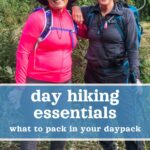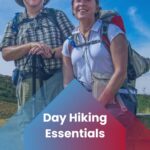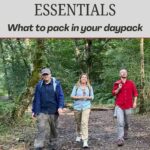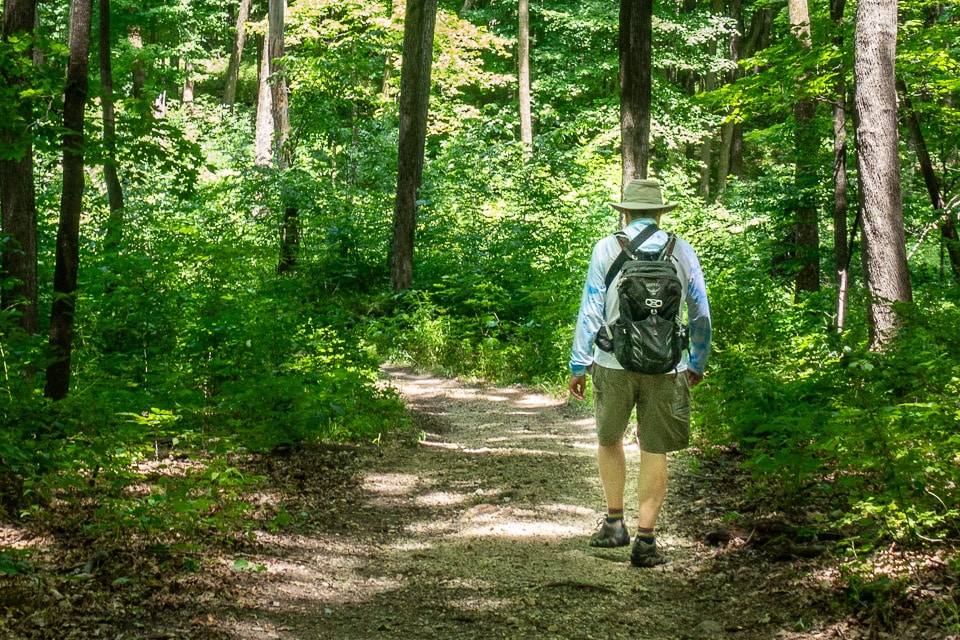
We do a lot of day hiking. We've done it pretty much all over the world: Minnesota (where we live), France, Spain, Guatemala, Tasmania, and Cambodia, to name a few. Over those years and miles, we've gotten pretty good at knowing what are the most important items to carry on a short hike or longer hikes – and what we can leave behind. And that's the real key to a day hiking trip: have everything you need; don't carry any extra weight you don't have to; and be ready if something doesn't go exactly according to plan.
So, this essential day hike packing list will be comprehensive, and prepare you in case you're hiking somewhat far from civilization – and where you parked your car. There, you're going to need to be more self-sufficient. Obviously, there are some things you can leave behind if you're hiking in more urban environments, where you're not far from help if you need it.
So, let's get started on the list.
Table of Contents
What is the best hiking day pack?
The answer to that depends on your own preferences, but here are the packs for day hikes that we carry.
The best hiking day pack for men
Tom carries the Osprey Talon 22. The 22-liter size is plenty to carry all the gear you need, and leaves plenty of room for extra clothing such as a warm base layers and packable rain jacket should the need arise.
Here is why we think the Osprey Talon 22 is the best choice for a men's day pack. It's very light. The small/medium version weighs 1.9 lbs (0.94 kg) and holds 20 liters. The large/XL version weighs just a little over 2.3 lbs (1.06 kg) and gives you the full 22 liters. Note, it's a great advantage that these packs come in sizes. Choose the one that fits your torso.
The pack is organized to carry what you need and give easy access to the things you're likely to want along the trail. First there is a separate top pocket that you can open without opening the main compartment. That's where I put my Buff gator, my phone, a lighter, and my energy bar or trail mix. I also put my headlamp and extra batteries in there.
The Osprey Talon also has my favorite feature: small pockets on both sides of the waist belt. That’s where I keep my pocket knife, lip balm, insect repellent, and a small pack of tissues. Those make it so easy to get to things without taking off the pack.
On the outside, The Talon has clever elastic ties and two outside mesh pockets on the sides that come in handy for stashing your trekking poles, a water bottle, and whatever else you want to keep extra handy. There’s also a larger center mesh pocket, which is where I usually stash my sunglasses case, sunscreen, and my trail map of the area I'm hiking.
In the main compartment, there is a mesh interior pocket for the smaller stuff, like your compass. That’s also where I put my wallet and keys when I'm hiking.
In the large main compartment, the Talon 22 easily carries all the stuff we list below with room left for a light down jacket, a rain jacket, or extra warm shirt for layering – or for stuffing in a few extras for an impromptu overnight trip. Note: you also might want to get a rain cover for your pack, just in case there’s something in there that would suffer from being wet. The pack itself is probably somewhat water resistant, but I’d want to be sure in case you get caught in a downpour.
Finally, there's a separate compartment for a hydration bladder. There's plenty of debate about whether to carry a bladder or a water bottle. But I carry a bladder for one reason: it's easy to take a drink by bringing the tube up to your mouth, as opposed to reaching behind you into a side pocket for your water bottle, and then struggling to put it pack in its pocket. Sometimes, to avoid that hassle, I've been known to just skip the sip of water. Avoid dehydration. Make drinking your water as easy as possible.
The best hiking day pack for women
Kris uses the Osprey Skimmer 20, which is slightly smaller, and lighter than the Talon, and is sized for a petite woman.
It has most of the same features as the Talon, but is a bit smaller and lighter – 1.37 lbs (0.62 kg.) And, the Skimmer has one big advantage: the hydration bladder is included in the price, which will save you about $70 over the price of the Talon and separate bladder.
Like the Talon, the Skimmer has a separate top pocket, a small interior pocket, and exterior side pockets. The only thing it's missing is the large exterior center pocket and the pockets on the waist belt. What all that means is you might have to swing the pack off and do a little more digging around to find what you need. Not a bad trade to save $70, probably.
Buy the Skimmer 20 from Osprey
Buy the Osprey Skimmer 20 on Amazon
Shoes
Your shoes are a matter of personal preference. There are lots of great options from lightweight trail runners to heavy waterproof hiking boots. Your choice will depend a lot on the weather and terrain where you're going hiking. Over the years, we've worn (and worn out) dozens of shoes. Lately, we've both become devotees of Xero shoes. We especially like the Find Your Shoe feature on the Xero site.
For heavier duty hiking, we're partial to Oboz. I have a breathable pair of low cut Oboz for summer, and a higher top waterproof version for winter.
The essentials for your day hiking pack
Water
The number one essential item for any sort of hiking is water. As I said above, I'm a fan of the hydration bladder. The other big benefit of the bladder is that it holds up to three liters of water. You can fill it all the way up if you think you're going to need it on long hikes, or part way for a shorter hike. Aside from the weight (a liter of water weighs one kg, or 2.2 lbs) it certainly is better to carry too much water than to run out half way through your hike.
I use the Osprey 3-liter hydration bladder. I like the ease of filling it with its wide mouth, and when I get home, I like that I can just hang it upside down, and put the plastic slide closure device into the mouth to hold it open so it can dry out. Another feature I like is the magnet on the tube near the mouth piece, which sticks to a corresponding steel ring on the pack's chest strap. Consequently, the bite valve is always near your mouth, not flopping around as you walk.
If 3 liters is more than you need, the water bladders also come in 2.5, 2, and 1.5 liter sizes.
Buy the 3L bladder from Osprey
Buy the Osprey bladder on Amazon
If you subscribe to the “belt and suspenders” theory of preparedness, you can also carry a lightweight water filter such as the Lifestraw, so you can draw from water sources on the trail in case of emergency.
Get the Lifestraw water filter at REI
The compass
You may debate whether you need a compass. And, honestly, if you're mostly sticking to urban and other well-marked hikes, you probably don't. But, as they say, better safe than sorry. Of course, a compass doesn't really do you much good unless you know how to use it. I'd highly recommend, before venturing into slightly more wild areas, that you take the excellent orienteering course offered by your local outfitter, orienteering club, or REI.
A compass, even if you don't use necessarily use it to orient yourself is kind of fun. If you have a good topo paper map, and know how to orienteer, it can be a lifesaver. Literally.
The headlamp or flashlight
I prefer a headlamp for ease of use, and for keeping your hands free. It's especially important if you're using hiking poles. But I also have a serious flashlight which throws a very strong beam. I actually usually carry both, because, well, if you need light, it's better to have a lot. Be sure to bring spare batteries.
Technology has advanced a lot since I bought my last headlamp, so I haven't personally tried the Black Diamond Spot 400 one linked here. But The Wirecutter, my favorite product review site, gives it its highest rating, so that's good for me. Kris has a Black Diamond headlamp – although not this exact model – and likes it a lot.
For a lighter and smaller alternative to a headlamp, consider the Fenix E05R rechargeable flashlight. It's about the size of your little finger, weighs less than one ounce (25 grams) and packs a 400 lumen punch. I like that it's small enough to fit in the belt pocket of the pack, too. And, of course, it's also convenient just to attach it to your everyday key ring. Be sure it's charged before you take it on a hike.
Buy the headlamp at Black Diamond
Pen with duct tape and writing pad
I wrap a couple yards of duct tape around a pen I picked up in a hotel somewhere. You don't have to carry an entire roll. Duct tape is the ultimate emergency repair kit. It has come in handy more than once – like when you catch your pack on some barbed wire and rip it. And, you can use the pen and pad to take notes on interesting things you see on the trail.
Sun protection: sunglasses
Your sunglasses are a personal choice. (In my case, they're prescription.) If you're buying some, get good ones. Your eyes are precious. I carry my sunglasses in a Nite Ize rugged glasses case. It is lightweight and rugged.
Buy the glasses case on Amazon
Sun protection: sunscreen
Again, sunscreen is a personal preference. You can get it anywhere. Just be sure you use it, especially on your face, neck, and ears.
Sun protection: a good hat
A good hat that shades your face, ears, and neck is an essential part of your sun protection scheme. I've had my Tilley AirFlo hat for about 15 years now and it still looks as good as new. I've hiked over 1000 miles in the hat. It's washable, fairly cool, and has strings that tie on both front and back to make sure it doesn't blow off in the wind. One feature I particularly like is you can just dip it in water, wring it out, and wear it. Very cool.
Also, when it gets dirty or sweaty, you can hand wash it in mild soap, or even toss it in the washing machine on delicate cycle.
Sun protection: sun-protective clothes
The REI Sahara Shade hoodie is simply a marvelous solution to two problems on the trail, sun and heat. First, it can cover you from head to waist completely as it has a collar to cover your neck, and, if you like, a light hood you can also pull up to cover your head. With SPF factor of 50, that provides plenty of sun protection. Often, if the sun is particularly strong, I put the hood up and put my hat on over it to shade my face. Also, the shirt wicks away perspiration and then any breeze that you get will add tremendously to the evaporative cooling effect. I've worn it both hiking and biking.
Buy the Sahara Shade hoodie from REI
Rain jacket
You can spend a lot or a little on a rain jacket. My best advice is to go to REI or your local outfitter and try them on and talk to the REI sales consultants (they are always very good, I've found.) And just pick one you like. There are plenty of good brands. I have a very old Columbia jacket that has served me well, and I just bought a Patagonia Torrentshell rain jacket that has already taken over as my favorite.
Buy the Torrentshell from Patagonia
Extra pair of socks
I always carry an extra pair of socks in my pack. Wet feet on the trail are a real pain, and can lead to blisters. So, if you trudge through a puddle or wet grass, you've got backup. Also, I've got into the habit of taking a break halfway through a long hike and drying my sweaty feet, applying foot powder, and changing my socks. Lately I've been partial to Point6 merino wool socks. They come in various weights from extra light to well padded, which is nice when you're hiking on mixed terrain. And, they're mostly wool, so they wick away moisture, helping to keep your feet dry in the first place.
A knife or multitool
The Swiss Army knife I carry is more utilitarian for the outdoors than the usual suspects. First, it's the knife the Swiss Army actually carries. And it has a very strong serrated blade. And a saw. No corkscrew though. If you're lugging wine with you on your hike, I recommend the stuff with screw tops.
If you're into camping, you might want a little more robust tool, like the Leatherman Signal, which is specifically designed more for camping (it has a hammer for your tent stakes.) The Signal also has a few other things such as a whistle, knife sharpener, and fire starting kit. Still no corkscrew, though.
Buy the Swiss Army knife on Amazon
Buy the Leatherman Signal on Amazon
Buy the Leatherman Signal at REI
A lighter or waterproof matches
Pick up a cheap lighter at the counter in any gas station. You'll probably never use it, but should you need to start a fire, it's a lot easier than rubbing two sticks together or using a fire starter. Or waterproof matches are an option, but the lighter works just as well.
Insect repellent
When it comes to bug repellent I go for the strong stuff – 100 percent DEET. Some don't like it, but my experience is that it works. And, I'm one of those people that mosquitos seem to love.
Whistle
I have a Fox sports official whistle left over from my younger days as a soccer referee. The Fox whistle is loud. And, if you're lost or separated from your companions, you want loud.
Trowel and wipes
We always carry these Combat wipes, as a kind of “high tech” toilet paper, and a lightweight trowel and practice the “Leave no Trace” philosophy. This trowel is a good one as it will cut through small roots and get through hard packed soil. And the Combat Wipes are biodegradable, so you can bury them, too. As they say, when you gotta go, you gotta go.
While we're on the topic of waste, be sure you carry an extra plastic bag to use as a trash bag to carry out anything you can't or shouldn't bury.
Trekking poles
I don't skimp on hiking poles. When you are going for distance, weight matters. And these Black Diamond sticks are ultra light and strong. They are expensive perhaps, and there are certainly cheaper alternatives. But, when you hike as much as we do, why not? Be sure you buy the length that's right for you. They come in shorter versions for women.
Here's my favorite tip for using trekking poles. If you're on a long descent, stop and lengthen your poles. That makes it much easier to brace yourself as you're going down.
Buy Black Diamond poles at Black Diamond
Buy Black Diamond poles at REI
Buy Black Diamond poles on Amazon
First-Aid kit
You can make up your own day hiking first-aid kit, or buy a light weight one that has the essentials. As for essentials, that's several Bandaids, a larger bandage or two, adhesive tape, tweezers for splinters, ibuprofen, antiseptic wipes, sterile gloves, antibiotic cream, hand sanitizer, and antihistamine or cortisone ointment for insect bites.
Optional gear
If you're going to be hiking in any areas where there is a chance you might be lost, have to stay after dark, or otherwise might be in peril, consider carrying these two items. Just in case.
A personal locator beacon
A personal locator beacon is an expensive tool, but, obviously, if you're lost in some wilderness with no cell service, it could be a life saver. The deluxe models are a combination satellite phone and gps device that can tell rescuers exactly where you are. If you are hiking in deep wilderness, give one of these every consideration. Also be aware that these devices usually require a service subscription.
Buy a locator beacon on Amazon
A RECCO. reflector belt
Our favorite travel belt brand, Arcade, has just released their RECCO belt. If you're not familiar with RECCO technology, it basically is a reflector that can be incorporated into “adventure” clothing to help rescuers find you if you're lost in the wilderness or buried in an avalanche. It's simple, light, and never needs recharging. A valuable safety tool to add to your hiking equipment. And, it's a lot cheaper than a beacon.
Emergency bivy
It of course a good idea before any hike to check the weather forecast for any incoming weather conditions that might be dangerous. Luckily, I've never had to use this emergency bivy, but I do carry it in my pack. It's basically a very light bag/blanket made of high-tech insulating material that will provide emergency shelter and retain your body temperature if you have to stay out over night or in cold weather. It only weighs a few ounces, so I carry mine all the time.
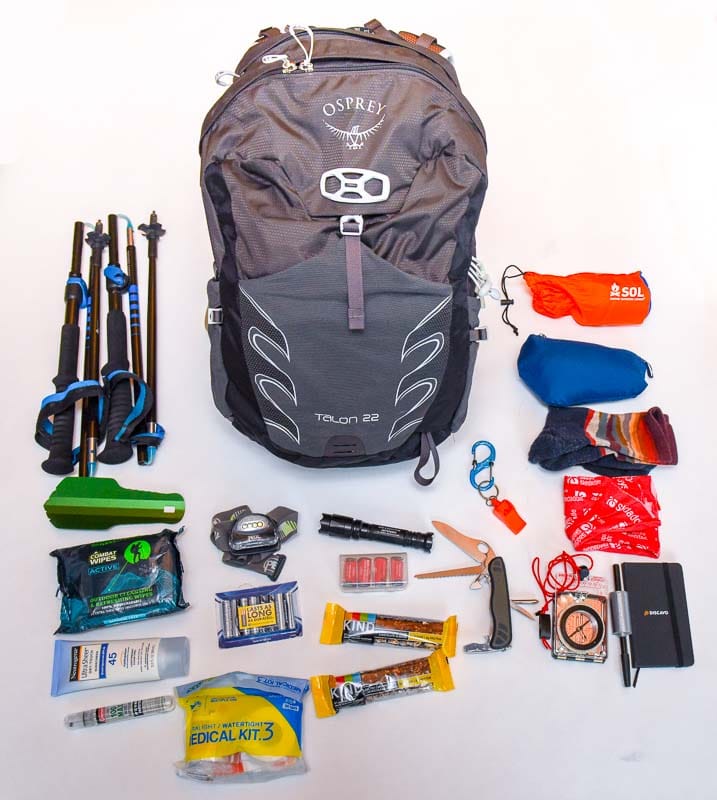
Up Your Travel Skills
Looking to book your next trip? Use these resources that are tried and tested by us. First, to get our best travel tips, sign up for our email newsletter. Then, be sure to start your reading with our Resources Page where we highlight all the great travel companies and products that we trust. Travel Accessories: Check out our list of all the accessories we carry to make getting there and being there a lot easier. Credit Cards: See our detailed post on how to choose the right travel rewards credit card for you. Flights: Start finding the very best flight deals by subscribing to Thrifty Traveler. Book your Hotel: Find the best prices on hotels with Booking.com. See all of the gear and books we like in one place on our Amazon shop.Got a comment on this post? Join the conversation on Facebook, Instagram, or Threads and share your thoughts!

